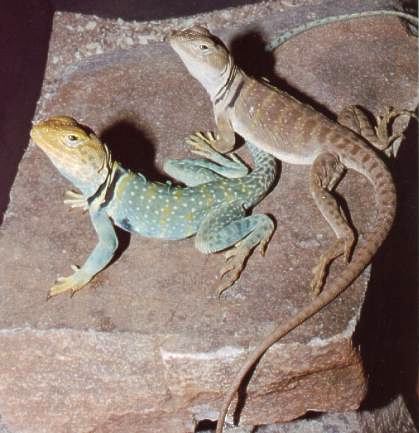Collared Lizard
Eastern Collared Lizard, Mountain Boomer Scientific Name: Crotaphytus collaris
Mon, 28th April, 2025 - 9:20 am GMT
Sponsor Ads:

Alternative Name
Eastern Collared Lizard, Mountain Boomer Scientific Name: Crotaphytus collarisBasic Info
This lizard has black bands behind its head that look much like a collar, giving it a look that has helped earn its common as well as scientific names. The collar is always present in males, but it may be missing in the female. This is one way to distinguish between the sexes. Their bodies are usually green with the head being a brilliant shade of yellow. The males often have boldly colored throats, hues of blue, green or orange. Their stomachs can also have large patches of blue, with spots of white, yellow or red. The females, in contrast, often have fawn or gray colorations that can gain red or salmon spots during the breeding season, which develop into orange lateral spots after mating. The average length for this species is between 8 and 14 inches.
Health
Collared Lizards generally need a good deal of space. A 20-gallon (76 Liter) vivarium should be considered the minimum for a pair. Housing two males together is strongly discouraged. The territorial nature of these lizards could make a situation such as this disastrous. Certain needs should be kept in mind while you landscape your Collared Lizards home. One factor is that Collared Lizards like to hide when they feel threatened. Steps should be taken to make sure there are a number of good retreats for the lizards throughout their new home. These lizards need full spectrum UV lighting for about 13 hours per day. These lizards also are used to hotter temperatures, often between 85-95º F (29-35ºC) during the day and 68-75º F (20-24ºC) during the nighttime. The enclosure should have a daytime temperature gradient of about 80 degrees Fahrenheit at the coolest end of the enclosure, a large area 85 - 90 degrees, and a basking area about 100º F. The nighttime temperature should be about 75º F. Light and humidity are also important factors. Unfiltered natural is the best sort of light for these animals. Fluorescent full spectrum/UV radiant reptile lights can be used when natural light is not possible. A shallow dish of water should be made available for the lizard at all times. The dish should be cleaned and refilled daily. The lizards should also be misted at least 2-3 times a week. Some lizards simply will not drink from their dish, in which case they will need to be misted daily. Breeding The mating season for the Collared Lizards is in the spring, with clutches varying from 1-12 eggs being laid in late June into July. The lizard's hatchlings generally appear in August and September, after approximately 10 weeks of incubation.Habitat
Rocky hillsides where they can huntBehavior
The Collared Lizard, also known as the Eastern Collared Lizard or "Mountain Boomer" has been known to escape danger in the wild by running on its two hind legs. Some people believe that this position gives this fairly long-lived lizard the look of a miniature Tyrannosaurus Rex. While occasionally eating plants, Collared Lizards are mainly carnivorous. Small mice, other small mammals, and even other lizards and snakes are all potential prey, though insects are generally the favored food staple. Additionally, the males of this species can be very territorial and often do not take well to other males being in its home range. Collared lizards prefer to flee in the face of danger, and can do so very well as they are adept runners and good jumpers. If left with no avenue of escape, they can bite very hard if needed. While largely harmless to humans, such a bite can break the skin on a person. A habit that potential owners might find interesting is that the Collared Lizard will wave its tail, much like a cat, when it is about to grab prey.Origin
North AmericaHistory
The Collared Lizard's range often extends from Kansas south to Texas and in to the northern parts of Mexico. The east and west boundaries of this reptile's range extends from western Arkansas to eastern Missouri. Most tend to reside on rocky hillsides where they can hunt as well as watch for danger.Common Foods
Food should be dusted twice a week with a calcium powder and once a week with a vitamin powder to make sure the pet gets all the nutrition it needs. Food that you can add to your Collared Lizards menu can include nutrient fed crickets, mealworms, waxwormSponsor Ads:
"It is owing to his information, again, that we can cause the doomed spy to carry false tidings to the enemy." -- Sun Tzu, The Art of War
Collared Lizard
Coded by: BGID® | ALL RIGHTS RESERVED Copyright © 2000-2025
Disclaimer | Privacy | Report Errors / Contact | Credits
















